Preparation of glutinous rice starch/polyvinyl alcohol copolymer electrospun fibers for using as a drug delivery carrier
Ptthnkorn Jiturong,Busn Sirithunylug,Sukum Eitsyem,Chwlinee Aswhme,Prthy Tipdungt,Jkkpn Sirithunylug,*
aDepartment of Pharmaceutical Sciences,Faculty of Pharmacy,Chiang Mai University,Chiang Mai 50200,Thailand
bDepartment of Physics and Materials,Faculty of Science,Chiang Mai University,Chiang Mai 50200,Thailand
cDepartment of Industrial Pharmacy,Faculty of Pharmaceutical Sciences,Huachiew Chalermprakiet University,
Samutprakarn 10540,Thailand
1.Introduction
Electrospinning is a fiber production technique which can fabricate fibers with diameters ranging from microscale to nanoscale[1–5].The electrospinning process has gained more attention in the past decade because of its versatility in spinning with a wide variety of polymeric fibers and its ability to consistently produce fibers in the submicron range that is otherwise difficult to achieve by using standard mechanical fiberspinning techniques[6].In addition,the electrospun fibers sizes are smaller than the fibers that are produced by other processes.The nanofibers which are obtained from electrospinning demonstrate higher surface areas to volume ratio.It is possible to manipulate electrospun fibrous diameter and their shape by altering the parameters in electrospinning process[5,7,8].Electrospun fibers show versatile applications in numerous fields such as filtration techniques,analytical chemistry,tissue engineering and drug delivery[9].Electrospun nanofibers have been reported that they are fabricated from various sources including synthetic polymers,natural polymers or a blend of proteins,nucleic acids and even polysaccharides[5].In addition,the desired physical properties of the fibrous matrices can be obtained by blending different types of polymer in a suitable proportion.For example, fibrous matrices that are prepared by blending a water-soluble and water-insoluble polymer can be used as controlled release carriers for drug delivery application[10–12].Recently,starch,a natural polymer,has been applied to the electrospinning process increasingly,especially in a hybrid form with synthetic polymers.
Starch is a well-known material that has been globally used in various industries such as textile,paper,plastic,food,cosmetic and pharmaceuticals.It shows many advantages including bio-sourced,renewable,biodegradable,biocompatible and inexpensive[13,14].There are varieties of starch commercially available,for instance,maize starch,potato starch,rice starch and glutinous rice starch.Starch is a common pharmaceutical excipient which functionalizes as a glidant,diluent,disintegrant,and binder in solid formulations[15].However,starch is a poor electrospun fiber forming agent as the starch fibers are brittle and water-sensitive[14].The literature reported that blending starch with linear chain polymer can improve the overall spinnability of the blends[14].Polyvinyl alcohol(PVA)is a synthetic polymer which shows a wide range of applications such as polymer industrials,pharmaceuticals,and foods.Its monomer unit is illustrated in Fig.1A.PVA is a hydrophilic semi-crystalline polymer which shows a good chemical and thermal stability.Additionally,it is a biocompatible material which is used in tissue engineering area.PVA has a low acute oral toxicity with LD50in a range of 15–20 g/kg.Furthermore,it is poorly absorbed into the body through a gastrointestinal tract[16].PVA shows an excellent spinnability[17–20].Therefore,blending starch and PVA in an optimal proportion can enhance the spinnability of starch.Glutinous rice starch(GRS)is a new alternative material to be combined with synthetic polymer especially with PVA.
GRS is produced fromOryza sativavar.glutinosawhich is commonly cultivated in the Northeast of Thailand.GRS contains two types of glucose polymers which are amylose and amylopectin.Amylose contains 250–2000 glucose units that are mostly arranged in essentially linear chains of α-1,4-linked glucose units.However,there are some amyloses that link by α-1,6-glucosidic bonds.Amylose is a minority component in GRS which presents less than one percent.Amylopectin is a glucose polymer that has a branched chain of 25–30 glucose residues which are linked by α-1,4-glucosidic bonds and α-1,6-glucosidic bonds.GRS contains more than 99%of amylopectin[21–23].Thus,it exhibits a branch chain structure(as seen in Fig.1B).The branch chain structure of GRS obstructs a polymer chain entanglement process during electrospinning,resulting GRS is a poor electrospun fiber forming agent.GRS shows a few pharmaceutical applications,for instance,a sustain release modifier in direct compression tablet[21]and preparing mucoadhesive microbead for controlled release[24].It would be interesting if we can expand a pharmaceutical application of GRS innovatively as a co-electrospun matrix for drug delivery.
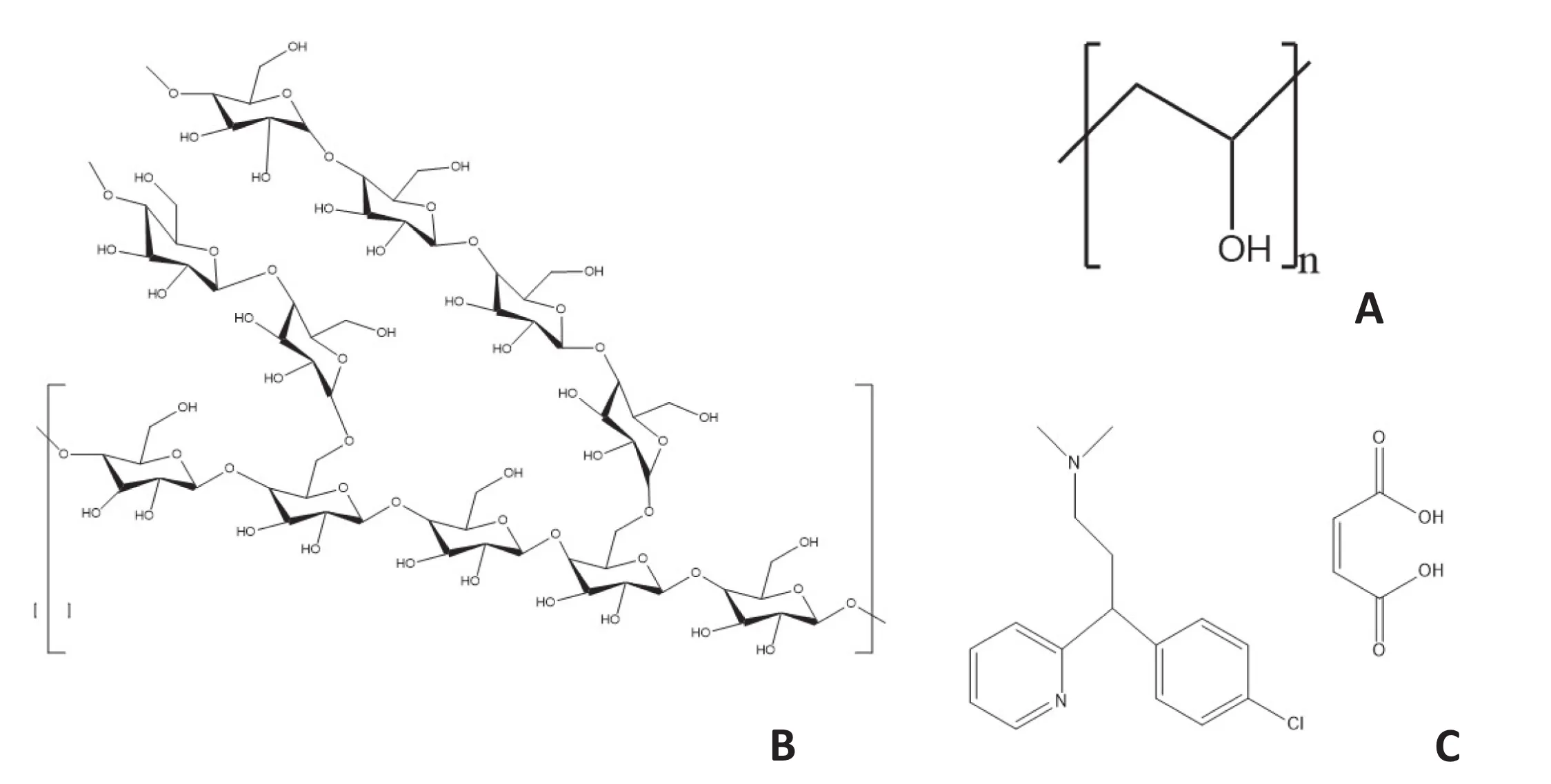
Fig.1–Molecular structure of(A)PVA monomer,(B)GRS and(C)CPM.
This study aimed to explore a novel pharmaceutical application of GRS as a co-electrospun matrix with PVA in the oral route drug delivery carrier.The properties of the electrospun fibers which contained different ratios of PVA and GRS were studied including fiber formation,swelling power,and solubility index.Chlorpheniramine maleate(CPM),a first-generation antihistamine drug,was incorporated into to GRS-PVA fibers as a model drug for tracking the performance of highly watersoluble drug release from the hybrid fabricated fibers.The CPM GRS-PVA fibers were characterized by their physical properties and performed the drug release to prove a concept of drug delivery carrier.
2.Materials and methods
2.1.Materials
Polyvinyl alcohol(PVA)MW≈85,000–124,000 Da was purchased from Sigma-Aldrich(Germany).Glutinous rice starch(GRS)was supplied from General Food Product Co.,Ltd.(Thailand).CPM was purchased from S.Tong Chemicals Co.,Ltd.(Thailand).SEA CHLOR?(SEA PHARM CO.,LTD.,Lot No.5374C)was a commercial chlorpheniramine maleate,4 mg tablet.
2.2.Methods
2.2.1.Solution preparation method
PVA was dissolved in hot water(95±5°C),continuously stirred for 15 min then cooled to 65±5°C.GRS was then added to PVA solution and stirred for 15 min.The PVA-GRS polymer solutions were cooled to room temperature then CPM was incorporated into the PVA-GRS solution and stirred for 10 min.The composition of electrospun fibers is reported in Table 1.
2.2.2.Electrospinning process
A single nozzle electrospinning setup was used in this study.A high voltage power supply(SL600,Spellman,USA)of 18–20 kV was attached to a metal nozzle to create voltage differences between the metal nozzle and a grounded collector.A charged metal nozzle with 0.9 mm outer diameter was placed with the syringe and set the distance from the center of an aluminium drum which is the grounded collector at 15 cm.A mechanical pump was used to deliver the polymer solution from a glass syringe to the metal nozzle at a rate of 300μl/hr.Operating conditions were fixed to reduce experimental variability.
2.2.3.Morphological characterization of nanofibers
The morphology of GRS-PVA nanofibers was characterized by using a scanning electron microscope(SEM)(JSM-5910LV,JEOL,Japan).The average diameter(n=10)and size distribution was obtained by analyzing SEM images using the ImageJ analysis program.
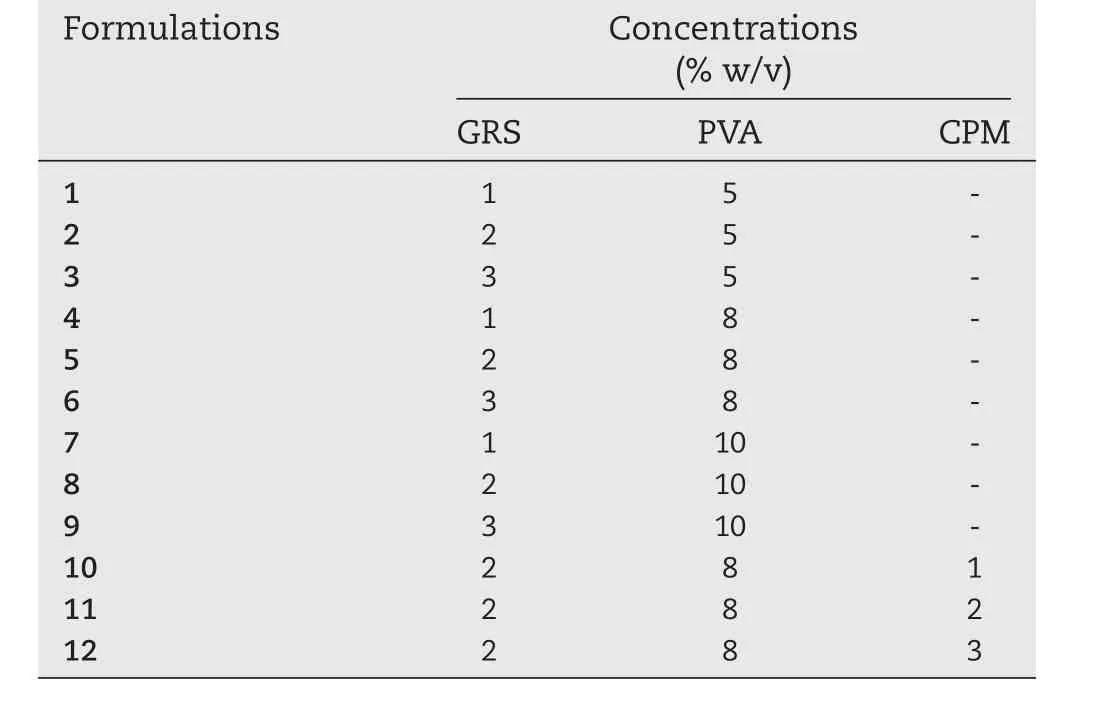
Table 1–Compositions of the electrospinning solutions in this study.
2.2.4.Swelling power and water solubility index
The swelling power and water solubility index of electrospun copolymer fibers were studied according to the method of Kong et al.[25]with some modifications.One hundred milligrammes of the sample was weighed directly into a screw-cap test tube,and 10 ml of distilled water was added.The capped tubes were then vortexed for 10 s and incubated at various temperatures;37 °C,45 °C and 60 °C in a water bath for 30 min.After that,the tubes were cooled to a room temperature and centrifuged at 2000 g for 30 min.The supernatant was removed;the cloudy solid layer was considered as supernatant and only the material that adhered to the wall of the tube was considered to be the sediment and weighed(Ws).The supernatant was dried to constant weight(W1)in a forced-air oven at 100°C.The water solubility index(WSI)and swelling power(SP)were calculated by the following equations:

The swelling power and water solubility index will support and clarify possible mechanism of CPM release from the GRSPVA nanofibers via swelling and solubility of GRS in the fibers.
2.2.5.Thermal properties
Thermal properties were analyzed by using a Differential Scanning Calorimeter(DSC7,Perkin Elmer,USA)by Kong et al.[25]with some modifications.Two milligrams of each sample was weighed in an aluminum pan and 6μl of distilled water was added.The pan was hermetically sealed and equilibrated at room temperature for 1 h,then heated at the rate of 10°C/min under a nitrogen atmosphere from 30 to 120°C with an empty sealed pan as a reference.Parameters,such as onset(To),peak(Tp)temperature and enthalpy(ΔH)of gelatinization were measured.
2.2.6.Fourier transform infrared spectroscopy(FTIR)
The FTIR spectra of GRS,CPM,PVA and CPM-GRS-PVA nanofibers were scanned in an FTIR spectrometer(Nicolet 470 FT-IR,Thermo Electron Corporation,USA)by Mathew et al.[11]The sample of electrospun fibers was mixed with KBr and molded into a disc.The spectra were acquired in the range of wavenumbers from 500 to 4000 cm?1.Samples were analyzed in the transmittance mode based on 32 scans and a resolution of 2 cm?1.
2.2.7.In vitro drug release
A USP dissolution apparatus I(SR8-Plus,Hanson Research Corporation,USA)by Laovachirasuwan et al.[21]was used to characterize the release of CPM from nanofibers.The basket containing CPM nanofibers was rotated at 50 rpm.Five hundred ml of 0.01 N hydrochloric acid was used as the dissolution medium.The medium temperature was controlled at 37.0±0.5°C.The dissolution medium from each vessel was sampled at predetermined time intervals(1,3,5,10,15,30,45,60,90 and 120 min)and immediately replaced with the fresh warm medium.The amount of CPM that released from electrospun fibers was analyzed by using a spectrophotometer(UV-2450,Shimadzu,Japan)at wavelength 265 nm.The measurements were carried out in triplicate.The quantity of CPM that released from electrospun fibers was calculated using standard CPM calibration curve within the range of concentration at 1.95–31.25 μg/ml.The linear regression equation was Y=0.0191x+0.0137(R2=0.9996).Thein vitrodrug release was performed under a sink condition.
2.2.8.Release data analysis
In this study,Korsmeyer-Peppas model and biphasic model were employed to evaluate the dominant mechanism of the CPM release by fitting to thein vitrorelease data.The Korsmeyer-Peppas model,a semi-empirical model for evaluating drug release behavior[26,27],was used to con firm the behavior of the commercial CPM tablets.The Eq.(3)shows an expression of the Korsmeyer-Peppas model.

Mt/M∞is a fraction of the drug release at time t,k is a constant that reflects geometric of the interested sample,n is the diffusion exponential that indicates a mechanism of the drug release behavior and t is time(min).From Korsmeyer-Peppas model,the behavior of the drug release can be categorized into three behaviors including Fickian diffusion(n=0.5),Case-II diffusion or Zero diffusion(n=1)and anomalous transport(n=0.5–1)which is a combined mechanism of Fickian diffusion and Case-II transport[26,27].Ritger et al.recommended fitting only the first 60%of the drug release data to obtain the valid prediction from the Korsmeyer-Peppas model because this model assumes that the drug release is a single dimensional release[27].
The biphasic release model is developed by Tipduangta et al.[10].It is a descriptive mathematical model which is based on the assumption that the polymer blend fibers contain two immiscible population polymer domains and each domain demonstrates independently release drug at a different rate.In this study,the two domains were PVA and GRS which assume that has independently release CPM at a different rate.Eq.(4)is the first order mass transfer equation that is used to describe the fraction of the drug release at time t,in which Mtis,mass remaining at time t,k is a constant,and M∞is total drug release at infinity.Thus,in this case,the biphasic mass transfer can be expressed using Eq(5),in which kaand kbare exponents of the GRS and PVA phases,respectively.

3.Results and discussion
3.1.Morphology characterization of nanofibers
SEM characteristics of GRS-PVA electrospun fibers are illustrated in Fig.2 and fiber diameter sizes of each formulation were reported in Table 2.The smooth fibers were obtained at PVA concentration from 8%to 10%(w/v).At 5%PVA(w/v),it was not possible to obtain smooth fibers,as seen in Fig.2A-C.They are beaded fibers in which similar to the findings from Supaphol and Chuangchote[20].The GRS-PVA nanofibers that contain 8%PVA(w/v)with 1–3%GRS(w/v)formed smooth fibers with an average diameter of 191–263 nm as shown in Fig.2D-F.The copolymer nanofibers of 10%PVA(w/v)with 1 and 2%GRS(w/v)also formed smooth fibers,but they demonstrated a larger fibrous diameter than the copolymer nanofibers of 8%PVA(w/v)with 1–3%GRS(w/v).On the other hand,increasing GRS to 3%(w/v)with 10%(w/v)PVA was not possible to fabricate the nanofibers because the solution possessed a high viscosity.Consequently,it led to a clogging at the tip of the needle which impedes electrospinning process.Starch has been reported as detrimental to an electro spinnability of polymer blends[28].
The preparation of 8%(w/v)PVA with 2%(w/v)GRS which demonstrated smooth copolymer nanofibers was selected for approving the concept of drug delivery carriers.CPM as a model drug was incorporated into this proportion of GRS-PVA nanofibers.SEM images of CPM-GRS-PVA nanofibers are illustrated in Fig.2(I-K)in which CPM concentrations are 1,2 and 3%(w/v),respectively.Nevertheless,only the 2%CPM(w/v)GRSPVA fibers show a smooth fibrous appearance with an average diameter of 168±44 nm.Thus,the 2%CPM(w/v)in GRS-PVA fibers were selected as a candidate to prove a hypothesis of using GRS-PVA as a drug delivery carrier.On the other hand,1%and 3%(w/v)CPM loaded in GRS-PVA blend were beaded nanofibers.Drug loading causes beaded fibers has been reported in the literature.The beaded fibers root from a number of reasons such as an insufficient voltage,inadequate polymer concentration,and high surface tension solutions[4,29].Thus,adding drug which is a small molecule compound into the solution may alter the overall surface tension of the solution in which resulting beaded fibers.
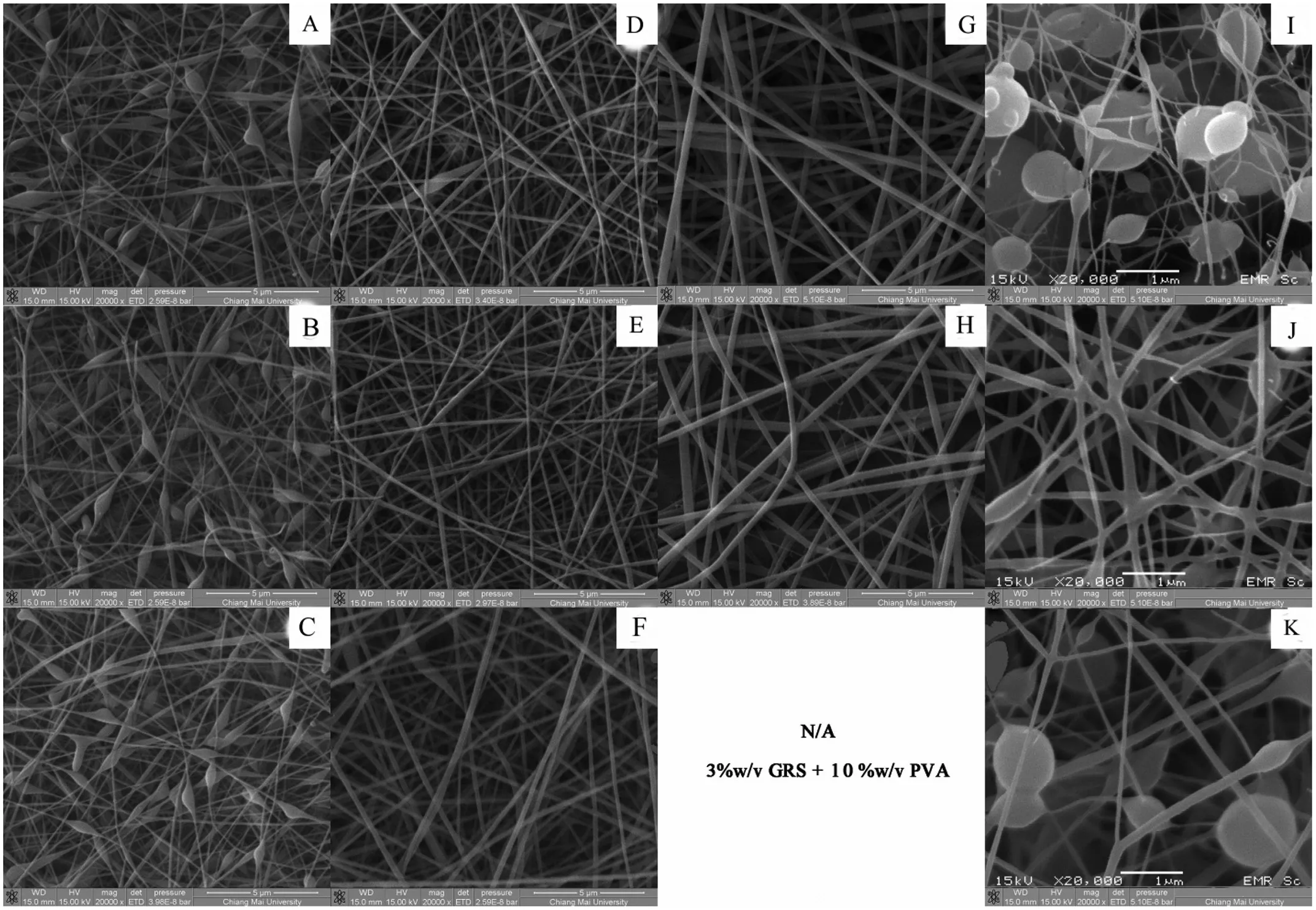
Fig.2–SEM images of(A)1%(w/v)GRS+5%(w/v)PVA,(B)2%(w/v)GRS+5%(w/v)PVA,(C)3%(w/v)GRS+5%(w/v)PVA,(D)1%(w/v)GRS+8%(w/v)PVA,(E)2%(w/v)GRS+8%(w/v)PVA,(F)3%(w/v)GRS+8%(w/v)PVA,(G)1%(w/v)GRS+10%(w/v)PVA,(H)2%(w/v)GRS+10%(w/v)PVA,(I)2%(w/v)GRS+8%(w/v)PVA+1%(w/v)CPM,(J)2%(w/v)GRS+8%(w/v)PVA+2%(w/v)CPM,(K)2%(w/v)GRS+8%(w/v)PVA+3%(w/v)CPM.
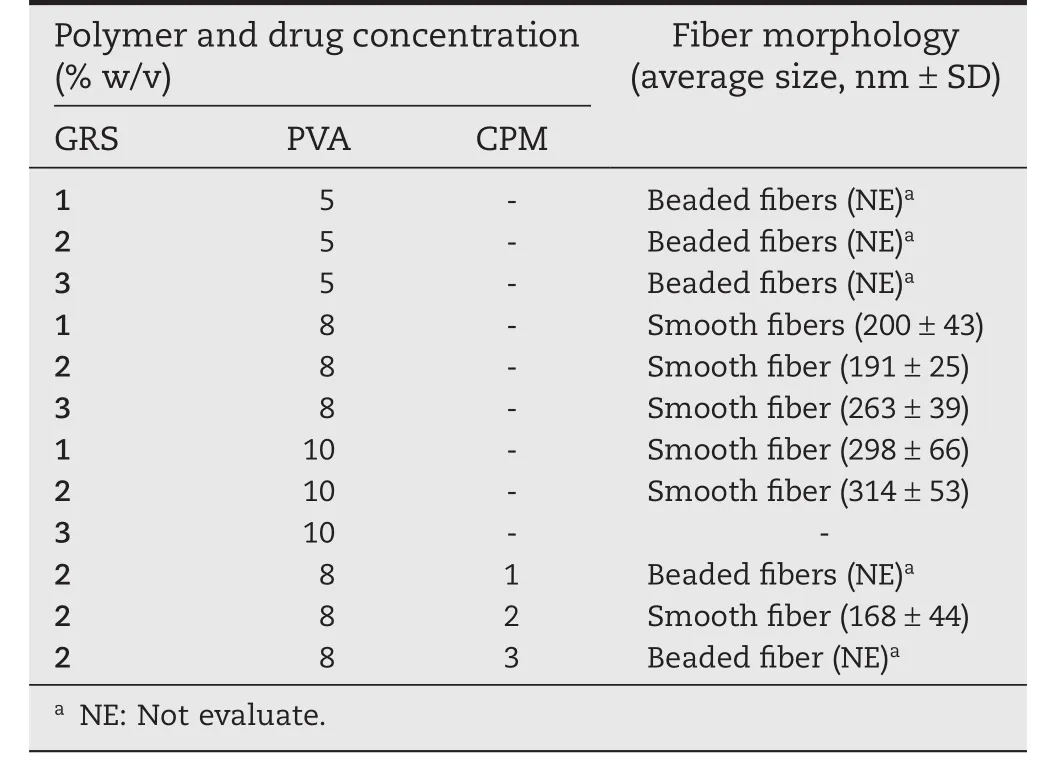
Table 2–Fiber morphology of the electrospun copolymer nanofibers.
3.2.Swelling power and water solubility index
Fig.3 shows the results of the swelling power and water soluble index compared between the physical mixture of GRS and PVA at ratio 2:8 and the sample of copolymer electrospun fibers of 2%(w/v)GRS with 8%(w/v)PVA at 37,45 and 60°C.The results show that the swelling power of copolymer electrospun fibers was lower at all temperatures in comparison to their physical mixture(Fig.3A).Swelling power reveals the water holding capacity of starch which is mixed with PVA in the fabricated fibers.The reduction in swelling power is due to the increase in a soluble portion of the copolymer.On the other hand,water solubility index is the percent amount of starch and PVA leached out into the supernatant during the swelling power determination.The result in Fig.3B shows that water-soluble index of the physical mixture was lower than those of the copolymer electrospun fibers at all temperatures.This is because the copolymer electrospun fibers are in nano size which potentially provides an extremely large surface area to volume ratio,therefore,it enhances water penetration into the fibers.Furthermore,GRS was added to a hot solution of PVA(around 65–70 °C)during the preparation of copolymer solution for electrospinning process.Therefore,it transforms GRS to a partial gelatinization state in the GRS-PVA electrospun fibers.As a consequence,the high surface area to volume ratio and partial gelatinization of GRS results in increasing a water solubility index of copolymer electrospun fibers.The decrease in the swelling power of copolymer electrospun fibers in comparison to the physical mixture indicates that the fibers have the less swollen capacity.The high water solubility index of copolymer electrospun fibers in comparison to the physical mixture refers to that they have high proportion which can be easily dissolved in water.The results of the swelling index and water solubility index reveal a great potential of the hybrid electrospun nanofibers as a drug delivery carrier in monitoring drug release.
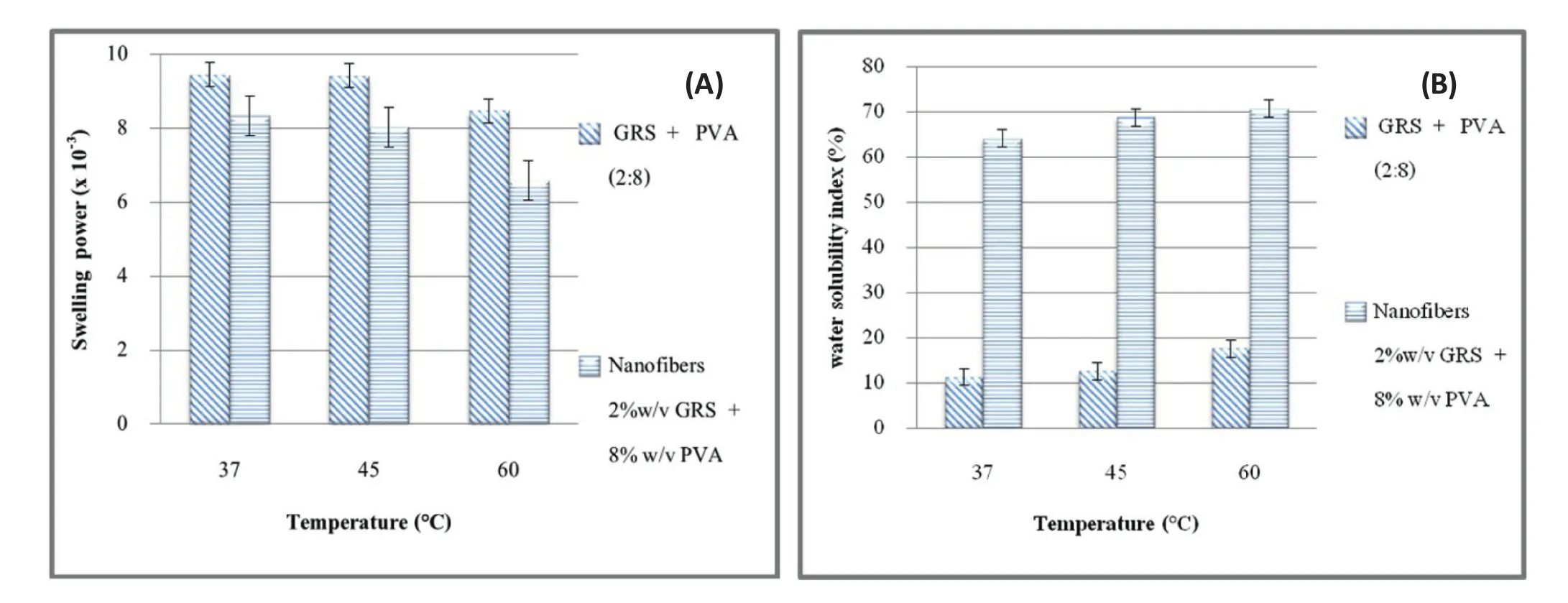
Fig.3–(A)Swelling power,(B)Water solubility index of GRS-PVA electrospun fibers compared with a physical mixture of GRS and PVA at ratio 2:8,studied at 37,45 and 60°C.
3.3.Thermal properties and interaction between drug and polymers
The thermal properties of copolymer electrospun fibers of 2%(w/v)GRS with 8%(w/v)PVA that incorporated with 2%(w/v)CPM as model drug revealed three main peaks as shown in Table 3.These peaks corresponded to the approximate peak gelatinization temperature of GRS at 57.33°C,melting temperature of CPM and PVA at 138.31 and 210.25°C,respectively[18,25,30].In the literature,electrospinning has been recognized as the method that can render a drug in its amorphous state because of its extremely fast solvent evaporation resulting in freezing the drug and polymer in a non-equilibrium state[2,9,10,31].The presence of CPM melting peak may cause fromthe gelatinization analysis method that needs to add some distilled water to the fiber during a DSC experiment.
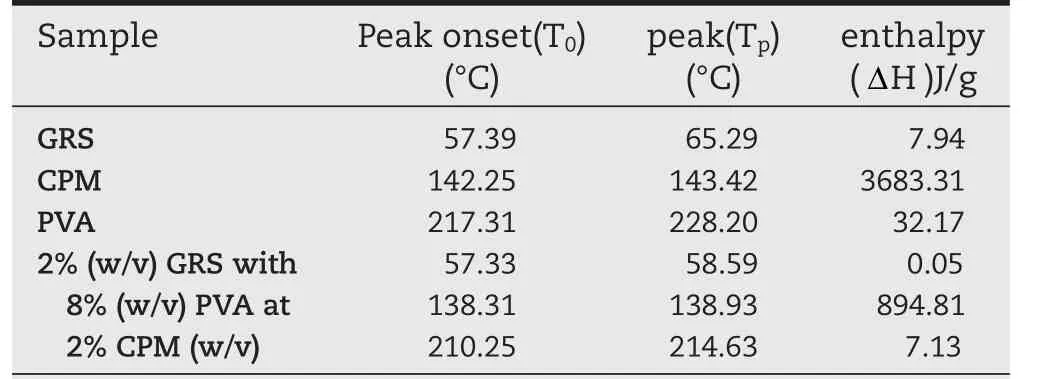
Table 3–The thermal properties of GRS,PVA,CPM and nanofibers obtained from the DSC analyses.
The FTIR was used to evaluate the interaction between CPM and polymers.The FTIR results showed that all of the characteristic IR peaks of CPM,PVA,and GRS presented in the CPM GRS-PVA fibers at their original wavenumber positions but they have lower peak intensity due to their proportion in the formulation(Fig.4).This indicates no interaction between CPM with PVA and GRS.
3.4.In vitro drug release
The commercial CPM tablet demonstrated a virtually linear release pro file which achieved a complete drug release at 30 min(Fig.5).This release pro file indicates that CPM constantly releases in an almost linear fashion.While the 2%CPM GRSPVA nanofibers exhibited an initial burst release with up to 60%,CPM released within the 10 min and reaching 90%at 120 min as shown in Fig.5.This release behavior is likely to be a biphasic release.To assess the drug release behavior of CPM commercial tablets and 2%CPM GRS-PVA nanofibers,theirin vitrorelease data were fitted to the Korsmeyer-Peppas model(Eq.(3))and biphasic model(Eq.(5)).
The diffusion exponential(n)and a constant(k)of the commercial CPM tablet were 0.748 and 3.945,respectively with a correlation coefficient(r2)of 0.96.The n value of the commercial CPM tablets is between 0.5–1.0.Thus,it indicates an anomalous transport which is a combined mechanism between Fickian diffusion and Case II transport.The 2%CPM GRS-PVA nanofibers released data cannot fit the Korsmeyer-Peppas model because of an insufficient data point as this formulation showing a burst release that the release exceeds 60%within first 5 min.Therefore,it is only fit with the biphasic model.The data fitting result of 2%CPM GRS-PVA nanofibers shows a high goodness of fit(r2equal to 0.9967)and a distinctively difference between ka(0.0079)and kb(0.5838)which is the release exponent of GRS and PVA phase,respectively.These pieces of information indicate that there are two independent phases that have different release rates,one phase shows an extremely faster drug release than the other phase.
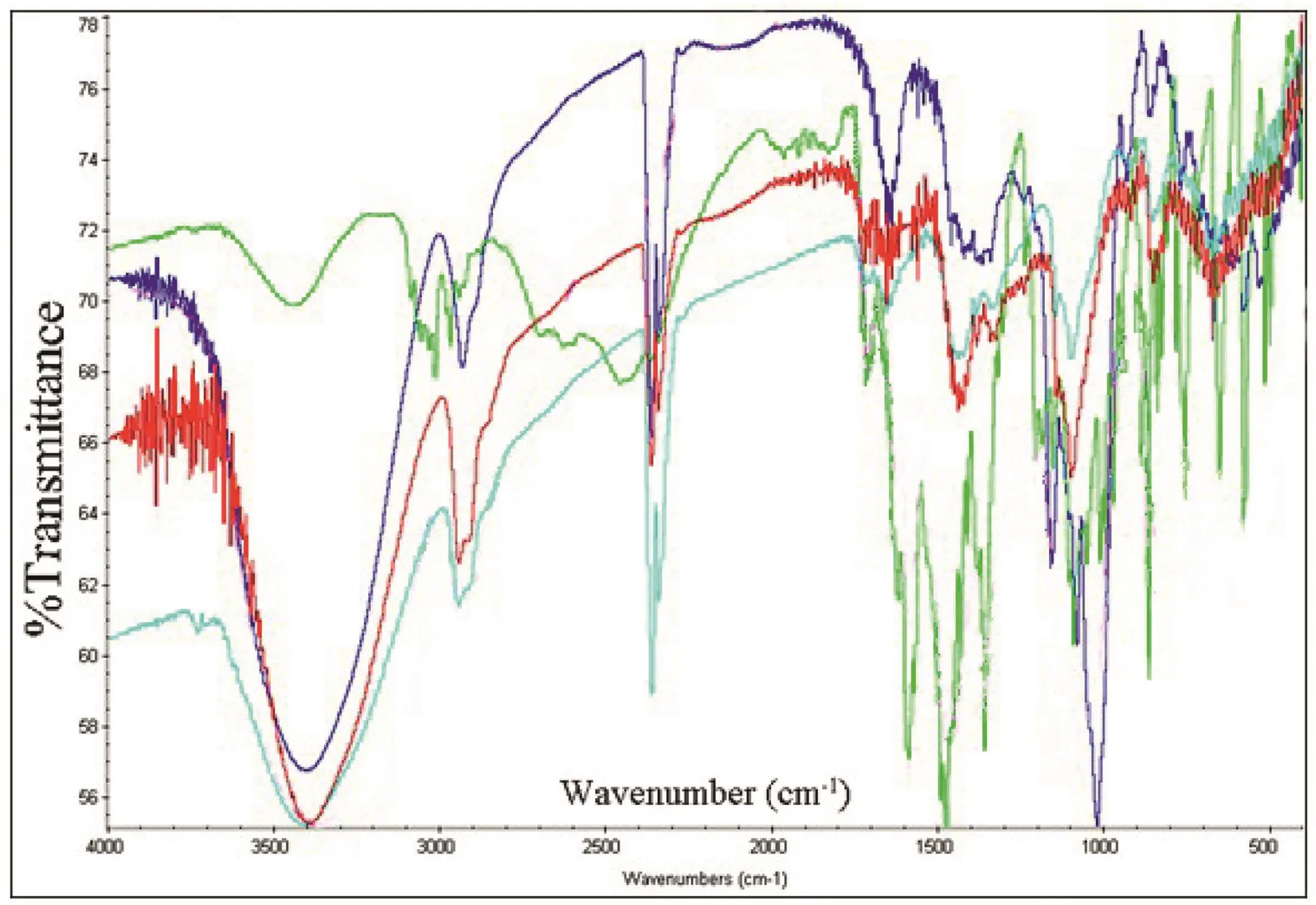
Fig.4–FTIR spectra ofGRS,PVA,CPM and2%(w/v)Fiber+2%CPM.
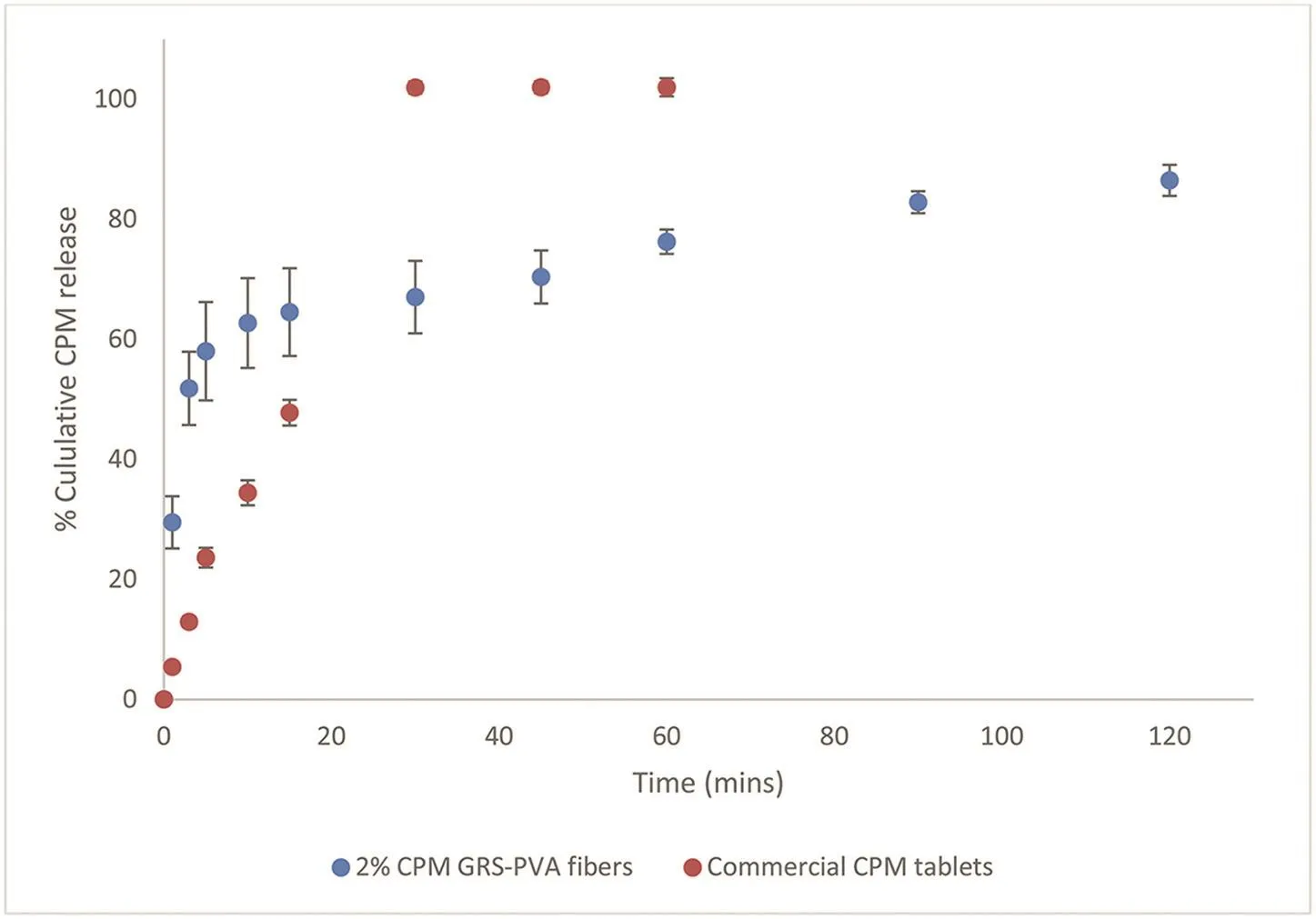
Fig.5–In vitrodrug release pro file of CPM loaded GRS-PVA nanofibers(blue)in comparison to the commercial CPM tablets(red).
A similar drug release behavior from electrospun fibers was reported by Tipduangta et al.[10].The authors discovered that paracetamol(PCM)distributed unequally in the blends of polyvinyl pyrrolidone(PVP)and hydroxypropylmethylcellulose acetate succinate(HPMCAS)electrospun fibers.The proportion of drug distribution in each phase is due to the miscibility of drug and polymers.PCM can form a hydrogen bond with PVP,but it does not interact with HPMCAS.As a consequence,approximately 60%PCM release within 10 min from PVP phase while the rest of PCM exhibited a sustained release from HPMCAS phase which was insoluble in water.In this study,we speculate that the initial burst release of CPM was from water soluble PVA phase which dissolved rapidly whereas,the rest of CPM that remained in the water-insoluble GRS phase demonstrated a sustained release.Therefore,a combination of GRS and PVA electrospun fibers showed a potential for using as drug delivery carriers for a biphasic release.
4.Conclusion
In this study,we developed GRS-PVA polymer blends electrospun fibers.The suitable proportion of GRS-PVA that produces smooth cylindrical fiber is at 2%(w/v)GRS with 8%(w/v)PVA.The GRS-PVA fibers show a high water soluble index which is a promising property as a drug delivery carrier.The CPM was incorporated into the 2%(w/v)GRS with 8%(w/v)PVA at 2%CPM(w/v)to prove a drug delivery carrier concept of the polymer blend electrospun fibers.The drug release pro file demonstrated a biphasic CPM release which the initial burst release was from PVA phase whereas the GRS phase exhibited a sustained release property.FTIR and DSC showed that there is no interaction between CPM and polymers.GRS-PVA electrospun fibers showed a potential as a drug delivery carrier that can achieve a biphasic release.Therefore,this study expands an application of a natural polymer GRS as a co-electrospun matrix for oral route delivery.Furthermore,they can potentially serve as a promised carrier for other related areas including cosmetics,nutraceutical,and food supplements.
Conflicts of interest
The authors report no conflicts of interest.The authors alone are responsible for the content and writing of this article.
Acknowledgements
The authors would like to express their sincere gratitude to the Graduate School,the Faculty of Pharmacy and the Faculty of Science,Chiang Mai University,Thailand for their financial supports.Authors acknowledge the support and encouragement from the Excellent Center of Pharmaceutical Nanotechnology,Chiang Mai University.
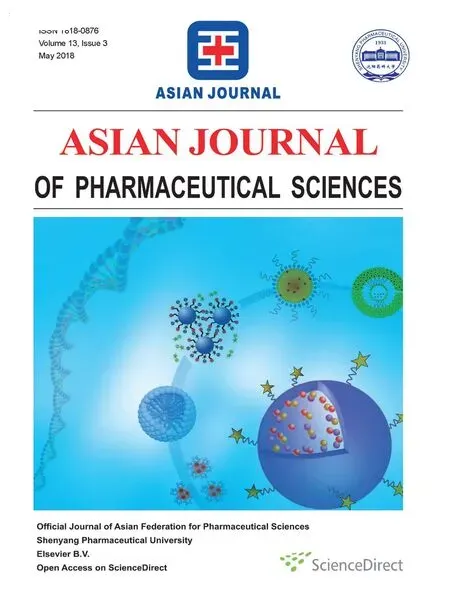 Asian Journal of Pharmacentical Sciences2018年3期
Asian Journal of Pharmacentical Sciences2018年3期
- Asian Journal of Pharmacentical Sciences的其它文章
- LAL test and RPT for endotoxin detection of CPT-11/DSPE-mPEGnanoformulation:What if traditional methods are not applicable?
- Activity of Brucea javanica oil emulsion against gastric ulcers in rodents
- Model evaluation for the prediction of solubility of active pharmaceutical ingredients(APIs)to guide solid–liquid separator design
- Systematically optimized topical delivery system for Loperamide hydrochloride:Formulation design,in vitro and in vivo biopharmaceutical evaluation
- Investigating the molecular dissolution process of binary solid dispersions by molecular dynamics simulations
- Intra-articular delivery of tetramethylpyrazine microspheres with enhanced articular cavity retention for treating osteoarthritis
